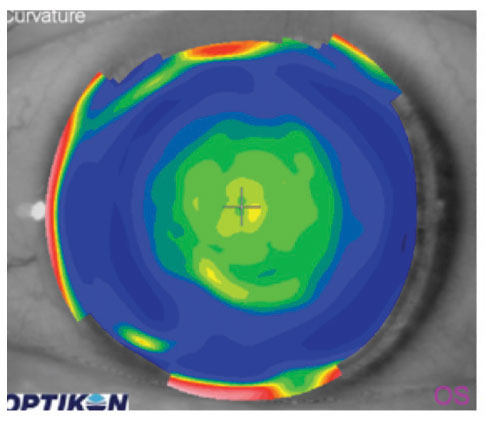 |
Center-near lenses may be a good option for presbyopes, study shows. Photo: Mile Brujic, OD. Click image to enlarge. |
Multifocal contact lenses are becoming a staple of myopia management efforts in children and remain essential for presbyopes, and researchers recently aimed to get a better understanding of visual performance differences in those with and without accommodative capacity. In their study, they evaluated a measure called through-focus visual acuity with center-near multifocals of three additions (low, medium and high) and in the absence of lens wear in 10 young adults and five presbyopes. They studied the effects of accommodation, age and pupil diameter on visual performance.
VA was found to be generally better in young adults than presbyopes.
“On one hand, we found that the multifocal contact lenses meet the purpose of gaining some near vision,” compared with no lens wear, “in presbyopes or in simulated presbyopia (paralyzing accommodation) in young adults. However, the multifocals did not improve near vision in the young adult group under natural accommodation but maintained near vision from dropping significantly in comparison with the far VA, keeping vision fairly constant from far to near,” the authors explained.
The multifocals slightly degraded visual quality with distance vision (up to 0.8logMAR). However, in young adults, VA did not fall below 0logMAR, which shows the lens is still able to provide good vision at distance. The degradation was slightly larger for presbyopes, which along with a poorer baseline VA at distance, resulted in a VA poorer than 0logMAR with all multifocals.
Under paralyzed accommodation, both in presbyopes and young adults, the depth of focus of the through focus curve increased with increasing pupil diameter (3mm to 5mm).
In young adults, the shape of the through focus VA curve was significantly different between paralyzed and natural accommodation conditions. In contrast, presbyopes did not show significant differences, which the authors expected “due to lack of accommodation in the older group.”
“In summary, center-near lenses do not degrade high-contrast VA significantly while maintaining far vision in young adults and produce some visual benefit at near in presbyopes,” the authors concluded. “Factors such as visual degradation at far, visual benefit at near and visual constancy (uniformity of vision across distances) should be considered in the management of myopia and presbyopia with multifocal contact lenses and to gain insights on the mechanism of operation of these lenses.”
They suggested future studies include contrast sensitivity and the Multifocal Acceptance Score metric for further guidance.
Vedhakrishnan S, Vinas M, Benedi-Garcia C, et al. Visual performance with multifocal lenses in young adults and presbyopes. PLoS One. March 17, 2022. [Epub ahead of print]. |

